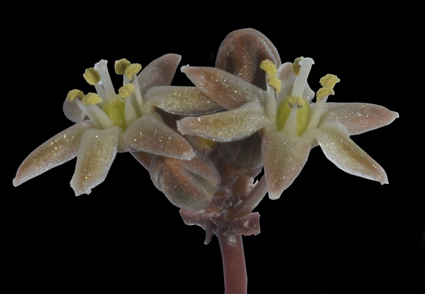Abstract
Our field work in the Eastern Cape Province of South Africa revealed an undescribed species of Austronea, which approaches A. marginata and related species, but differs in distinct morphological characters and distribution. We here describe Austronea oblongifolia to include plants showing bulbs with compact scales; a single, oblong, apiculate leaf that is appressed to the ground, and is minutely scabridulous on the upper surface with undifferentiated leaf margin; inflorescence subcapitate with a short peduncle; lowermost bracts with a broad spur; and reddish flowers with smooth filaments. We provide a complete morphological description, as well as data on ecology and distribution.
References
Brown, N.R. (1909) Asclepiadaceae: LIII Duvalia. In: Thisselton-Dyer, W.T. (Ed.) Flora Capensis; being a systematic description of the plants of the Cape Colony, Caffraria, & Port Natal vol. 4(1) part 6. Reeve & Co., London, pp. 1024–1036. [https://www.biodiversitylibrary.org/item/15242#page/1038/mode/1up]
Dold, A.P. & Brink, E. (2004) Drimia chalumnensis (Hyacinthaceae?Urgineoideae), a new species from Eastern Cape, South Africa. South African Journal of Botany 70 (4): 631–634. https://doi.org/10.1016/S0254-6299(15)30202-7
Haworth, A.H. (1826) XLVIII. Decas septima novarum Plantarum Succulentarum. The Philosophical Magazine and Journal 68: 326–331. https://doi.org/10.1080/14786442608674135
IPNI (Continuously updated) The international plant names index. Available from http://www.ipni.org (accessed 31 January 2023)
Leistner, O.A. & Morris, J.W. (1976) Southern African place names. Annals of the Cape Provincial Museum 12: 1–565.
Lessing, Ch.F. (1832) Synopsis generum Compositarum. Duncker et Humblot, Berlin, 473 pp. https://doi.org/10.5962/bhl.title.51470
Linnaeus, C. (1753) Species plantarum. Salvius, Stockholm, 1200 pp. https://doi.org/10.5962/bhl.title.37656
Manning, J.C. & Goldblatt, P. (2007) New species of Drimia (Hyacinthaceae: Urgineoideae) allied to Drimia marginata from Western and Northern Cape, South Africa. Bothalia 37 (1): 183–187. https://doi.org/10.4102/abc.v37i1.313
Manning, J.C. & Goldblatt, P. (2018) Systematics of Drimia Jacq. (Hyacinthaceae: Urgineoideae) in southern Africa. Strelitzia 40. South African National Biodiversity Institute, Pretoria, 173 pp. [http://hdl.handle.net/20.500.12143/6202]
Manning, J.C., Goldblatt, P. & Fay, M.F. (2004) A revised generic synopsis of Hyacinthaceae in Sub-Saharan Africa, based on molecular evidence, including new combinations and the new tribe Pseudoprospereae. Edinburgh Journal of Botany 60 (3): 533–568. https://doi.org/10.1017/S0960428603000404
Martínez-Azorín, M. & Crespo, M.B. (2014) Validation of several names in Hyacinthaceae. Taxon 63 (6): 1327–1334. https://doi.org/10.12705/636.21
Martínez-Azorín, M., Crespo, M.B. & Juan, A. (2007) Taxonomic revision of Ornithogalum subg. Cathissa (Salisb.) Baker (Hyacinthaceae). Anales del Jardín Botánico de Madrid 64 (1): 7–25. https://doi.org/10.3989/ajbm.2007.v64.i1.47
Martínez-Azorín, M., Crespo, M.B. & Juan, A. (2009) Taxonomic revision of Ornithogalum subg. Beryllis (Hyacinthaceae) in the Iberian Peninsula and the Balearic Islands. Belgian Journal of Botany 142 (2): 140–162. https://www.jstor.org/stable/41427183
Martínez-Azorín, M., Crespo, M.B., Alonso-Vargas, M.A., Dold, A.P., Pinter, M. & Wetschnig, W. (2018) Austronea (Asparagaceae, Scilloideae), a new genus from southern Africa, including the description of seven new species. Phytotaxa 365 (2): 101–129. https://doi.org/10.11646/phytotaxa.365.2.1
Martínez-Azorín, M., Dold, A.P. & Crespo, M. (2019) Austronea patersoniae (Asparagaceae, Scilloideae), a new species from the Eastern Cape Province in South Africa. Phytotaxa 400 (2): 76–80. https://doi.org/10.11646/phytotaxa.400.2.4
Martínez-Azorín, M., Pinter, M., Crespo, M.B. & Alonso-Vargas, M.Á. (2020) Austronea phyllopogon (Hyacinthaceae, Urgineoideae), a new species from the Kamiesberg, Northern Cape Province in South Africa. Phytotaxa 449 (2): 203–206. https://doi.org/10.11646/phytotaxa.449.2.10
Martínez-Azorín, M., Crespo, M.B., Alonso, M.Á., Pinter, M., Crouch, N.R., Dold, A.P., Mucina, L., Pfosser, M. & Wetschnig, W. (2023) Molecular phylogenetics of subfamily Urgineoideae (Hyacinthaceae): Towards a coherent generic circumscription informed by molecular, morphological and distributional data. Journal of Systematics and Evolution 61 (1): 42–63. https://doi.org/10.1111/jse.12905
Mucina, L. & Rutherford, M.C. (Eds.) (2006) The vegetation of South Africa, Lesotho and Swaziland. Strelitzia 19. South African National Biodiversity Institute, Pretoria, 807 pp. [https://www.sanbi.org/wp-content/uploads/2018/05/Strelitzia-19.pdf]
Nees von Esenbeck, C.G.D. (1832) Genera et Species Asterearum. I.D. Grüson, Vratislaviae, 310 pp. https://doi.org/10.5962/bhl.title.46989
Nees von Esenbeck, C.G.D. (1841). Florae Africanae australioris illustrationes monographicae. Prausnitz, Glogau, 490 pp. https://doi.org/10.5962/bhl.title.7585
Pfosser, M. & Speta, F. (1999) Phylogenetics of Hyacinthaceae based on plastid DNA sequences. Annals of the Missouri Botanical Garden 86 (4): 852–875. https://doi.org/10.2307/2666172
Pfosser, M. & Speta, F. (2001) Bufadienolides and DNA sequences: on lumping and smashing of subfamily Urgineoideae (Hyacinthaceae). Stapfia 75: 177–250.
Pfosser, M. & Speta, F. (2004) From Scilla to Charybdis ? is our voyage safer now? Plant Systematics and Evolution 246: 245–263. https://doi.org/10.1007/s00606-004-0153-z
Rafinesque, C.S. (1837) Flora Telluriana 3. H. Probasco, Philadelphia, PA, 100 pp. https://doi.org/10.5962/bhl.title.7751
Schrader, H.A. (1821) Moldenhawera. Göttingische Gelehrte Anzeigen, vol. 3. Weidmannsche Buchhandlung, Berlin, 818 pp.
Schwantes, G. (1926) Zur Systematik der Mesembrianthemen. Zeitschrift für Sukkulentenkunde 2: 177–189.
Schwantes, G. (1927) Zur Systematik der Mesembryanthemen. Zeitschrift für Sukkulentenkunde. Berlin 3: 14–30.
Speta, F. (1998) Hyacinthaceae. In: Kubitzki, K. (Ed.) The families and genera of vascular plants, vol. 3. Springer, Berlin, pp. 261–285. https://doi.org/10.1007/978-3-662-03533-7_35
Speta, F. (2001) Die Echte und die Falsche Meerzwiebel: Charybdis Speta und Stellarioides Medicus (Hyacinthaceae), mit Neubeschreibungen und Neukombinationen im Anhang. Stapfia 75: 139–176.
Steinheil, A. (1834) Note sur le genre Urginea nouvellement formé dans la famille des Liliacées. Annales des Sciences Naturelles, Botanique, Sér. 2, 1: 321–332. [https://www.biodiversitylibrary.org/item/150470#page/327/mode/1up]
Thiers, B. (Continuously updated) Index Herbariorum: A global directory of public herbaria and associated staff. New York Botanical Garden’s Virtual Herbarium. Available from: http://sweetgum.nybg.org/ih/ (accessed 31 January 2023)
Thunberg, C.P. (1778) Crassula Generis XXVIII. Novas Species in Capite bonae Spei detectas & descriptas. Nova Acta Physico-medica Academiae Caesareae Leopoldino-Carolinae Naturae Curiosum 6: 328–341. [https://www.biodiversitylibrary.org/item/132018#page/366/mode/1up]
Thunberg, C.P. (1794) Prodromus plantarum Capensium: quas in promontorio Bonæ Spei Africes, vol. 1. J. Edman, Uppsala, 84 pp. https://doi.org/10.5962/bhl.title.84
Willdenow, C.L. (1799) Caroli a Linné Species Plantarum. Editio Quarta, vol. 2(1). Impensis G.C. Nauk, Berolini [Berlin], 823 pp. https://doi.org/10.5962/bhl.title.60086


